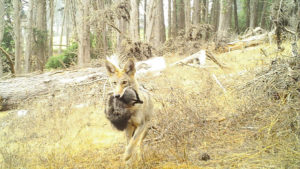Until now, coyotes have been safely keeping their biggest secret to themselves: their pups. But they will soon be taking the youngsters on wider and wider treks away from their dens, usually when it’s dark and when we humans aren’t around. If you are vigilant, even now you might be able to spot a youngster with a parent through an opening in the foliage if you are lucky.
Coyotes live in family units, not packs of unrelated individuals. We have a number of coyote families living in the city of San Francisco. Coyotes mate for life, and both parents raise the young and watch out for their safety — we’re talking about real family life here. It’s hard not to admire a species that puts so much effort into maintaining their own monogamous relationship and into the care and safety of their youngsters. Parents play with, bring food to, groom, defend, lead family outings, teach, tease and discipline their youngsters, not so differently from the way humans do: coyote life is about family life. Each family claims a territory from which other coyotes are kept out. This insures that there will be enough resources for the family unit.
How to get along with coyotes? Treat them as you would any other wild animal, such as a skunk or raccoon, by moving away from them and keeping your dogs away from them, which can only be done by leashing up! Leashing will keep your dog from chasing a coyote, and it will keep your dog close to you, thus discouraging a coyote from coming in closer to your dog. Coyotes will do their utmost to avoid humans and human encounters, so the issue isn’t about you. However, although they’ll shy away from people, they may give territorial messages to dogs who come too close, the same as they do to any other non-family coyote who might potentially threaten their territorial claims: this could result in a nip to your dog’s haunches — cattle-dog fashion — to get the dog to leave the area. And small pets may look like any other prey to them: so please leash your pets in known coyote areas and don’t allow them to roam free. Coyotes have been spotted wandering through virtually every park in San Francisco.
Everyone with a dog should know how to shoo off a coyote who has come too close — it’s know-how that’s needed just in case there’s an unexpected encounter. Simply harassing a coyote with screams, flailing arms and making yourself look big is often not effective. Coyotes get used to this and eventually ignore it as meaningless and quirky human behavior. It’s best actually to, 1) approach or charge towards the coyote, and to, 2) do so menacingly as though you’re out to get them, by eyeballing them with eye-to-eye contact and yelling “SCRAM, get out of here!” Often, your piercing gaze into their eyes alone is enough to get them to move on.
However — and this is an all-important caveat — if they absolutely do not move, it will be because pups are close by. In this case, it’s best to keep the peace by respecting their need to keep you out of the area they won’t move from: just back away rather than provoke an incident, without running. If one follows you, turn and face the coyote — he’s unlikely to come closer with your eyes glaring at him. However, if he just stands there, again, try charging in his direction as described above to get him off of your tail. As always, prevention is the best medicine — always keep your distance in the first place.
For a basic review of coyote behavior and simple coexistence guidelines, take a look at “Coyotes As Neighbors”, a YouTube video presentation found at the top of the page of the coyotecoexistence.com website, or press this link to go directly to YouTube: https://youtu.be/euG7R11aXq0. By knowing about coyotes, you’ll be able to deal better with an unexpected contingency. If you have specific issues, please contact the folks at coyotecoexistence@gmail.com. They are there to help you.





